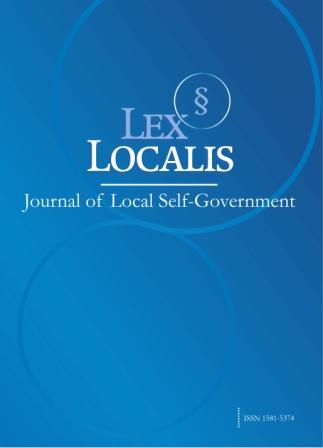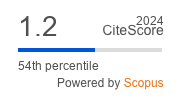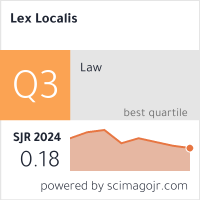Gospodarski vpliv zdravstvenega sektorja na regionalni ravni – primer majhnega, odprtega gospodarstva
DOI:
https://doi.org/10.4335/19.3.621-658(2021)Ključne besede:
izdelava regionalnih tabel vhodnih in izhodnih podatkov (GRIT), samoprilagodljiva diferencialna evolucija, študija gospodarskega učinkaPovzetek
Metodologija GRIT (Generation of Regional Input-output Tables – izdelava regionalnih tabel vhodnih in izhodnih podatkov) se uporablja za majhno državo s srednjim dohodkom, kjer je enotna nacionalna tabela vhodnih in izhodnih podatkov razdeljena na številne regionalne tabele. Podatki o manjkajočih vrednostih se pripišejo z uporabo evolucijskega stohastičnega algoritma za optimizacijo, ki temelji na populaciji, s samoprilagodljivimi kontrolnimi parametri in eksogenimi vrhunskimi podatki. Študija brez anket se izvaja za vsako regionalno gospodarstvo z izračunom različnih multiplikatorjev, kot so proizvodnja, dohodek, dodana vrednost, zaposlovanje in uvozni multiplikatorji, ter z opisom finančnih lastnosti, razvoja in medsebojnih povezav različnih regij v Sloveniji. Poleg tega so proučeni učinki financiranja regionalnih sektorjev zdravstvenega varstva. Empirični dokazi, da so sektorji zdravstvene industrije izjemno pomembni na regionalni ravni in so zato potrebni za doseganje ugodnega vpliva na nacionalno proizvodnjo Slovenije v prihodnosti, se lahko uporabijo za prihodnje načrtovanje gospodarskih politik na regionalni in nacionalni ravni.
Literatura
Arto, I., & Cazcarro, I. (2017) Hybrid (survey and non-survey) methods for the construction of subnational/regional IO tables with insights for their construction for Deltaic environments. DECCMA working paper.
Avdiushchenko, A. (2018) Toward a Circular Economy Regional Monitoring Framework for European Regions: Conceptual Approach. Sustainability, 10(12), 4398. https://doi.org/10.3390/su10124398.
Barca, F. (2009) An agenda for a reformed cohesion policy, Policy, 22.
Bekő, J., Jagrič, T., Fister, D., Brown, C., Beznec, P., Kluge, H., & Boyce, T. (2019) The economic effects of health care systems on national economies: an input-output analysis of Slovenia, Applied Economics, 51(37), https://doi.org/10.1080/00036846.2019.1588955.
Blažek, J., & Kadlec, V. (2019) Knowledge bases, R&D structure and socio-economic and innovation performance of European regions, Innovation: The European Journal of Social Science Research, 32(1), pp. 26–47, https://doi.org/10.1080/13511610.2018.1491000.
Boster, R. S. & Martin, W. E. (1972) The value of primary versus secondary data in interindustry analysis: a study in the economics of the economic models, The Annals of Regional Science, 6(2), pp. 35–44.
Brest, J., Greiner, S., Bošković, B., Mernik, M. & Žumer, V. (2006) Self-Adapting Control Parameters in Differential Evolution: A Comparative Study on Numerical Benchmark Problems, IEEE Transactions on Evolutionary Computation, 10(6), pp. 646–657, https://doi.org/10.1109/TEVC.2006.872133.
Cavalieri, M. & Ferrante, L. (2020) Convergence, decentralization and spatial effects: An analysis of Italian regional health outcomes, Health Policy, 124(2), pp. 164–173, https://doi.org/10.1016/j.healthpol.2019.12.001.
Ceylan, R. F., Ozkan, B. & Mulazimogullari, E. (2020) Historical evidence for economic effects of COVID-19, European Journal of Health Economics, 21(6), pp. 817–823, https://doi.org/10.1007/s10198-020-01206-8.
Czamanski, S. (1969) Applicability and limitations in the use of national input-output tables for regional studies, Papers of the Regional Science Association, 23(1), pp. 65–77.
De Noni, I., Ganzaroli, A. & Orsi, L. (n.d.) Measuring the effects of “green” innovations on the productivity of European regions.
Dias, A. C., Lemos, D., Gabarrell, X., & Arroja, L. (2014) Environmentally extended input-output analysis on a city scale - Application to Aveiro (Portugal), Journal of Cleaner Production, 75, pp. 118–129, https://doi.org/10.1016/j.jclepro.2014.04.012.
Espigares, J. L. N. (2016) Economic impact of healthcare systems: an inter-country input-output approach, Tiziana Russo-Spenaand Cristina Mele, 317.
Ferracuti, N., Socci, C., & Spigarelli, F. (2017) The healthcare industry in the Chinese economy: Insights from input-output analysis, Healthcare Policies and Systems in Europe and China: Comparisons and Synergies, pp. 79–107, https://doi.org/10.1142/9789813231221_0006.
Flegg, A. T., Webber, C. D. & Elliott, M. V. (1995) On the appropriate use of location quotients in generating regional input–output tables, Regional Studies, 29(6), pp. 547–561.
Gill, I. (2010) Regional development policies: Place-based or people-centred, VoxEU, 5644(October 2010), pp. 1–8, https://voxeu.org/article/regional-development-policies-place-based-or-people-centred.
Gunasinghe, C. (2015). An input-output modeling approach as an effective development strategy for Sri Lanka, Sri Lanka Journal of Economic Research, 3(2), p. 3, https://doi.org/10.4038/sljer.v3i2.76
Henke, K. (2013) The Economic and the Health Dividend of the Health Care System, Vilnius, Lituanie, pp. 19–20.
Iammarino, S., Rodríguez-Pose, A. & Storper, M. (2017). Why Regional Development matters for Europe’s Economic Future. Regional and Urban Policy Working Papers (European Commission), 7, pp. 1–31, available at: https://ec.europa.eu/regional_policy/sources/docgener/work/201707_regional_development_matters.pdf (March 20, 2021).
Isard, W., Langford Jr, T. W. & Romanoff, E. (1968) Philadelphia region input-output study working papers (Philadelphia: University of Pennsylvania).
Jagrič, T., Brown, C., Boyce, T. & Jagrič, V. (2021) The impact of the health-care sector on national economies in selected European countries, Health Policy, 125(1), pp. 90–97, https://doi.org/10.1016/j.healthpol.2020.10.009.
Jensen, R. C., Mandeville, T. D. & Karunaratne, N. D. (1977) Generation of regional input-output tables for Queensland, Report to the Co-Ordinator General’s Department and Department of Commercial and Industrial Development, Brisbane.
Jensen, R. C., Mandeville, T. D. & Karunaratne, N. D. (2017). Regional economic planning: Generation of regional input-output analysis. In: Regional Economic Planning: Generation of Regional Input-output Analysis, Vol. 9 (London: Routledge), https://doi.org/10.4324/9781315103228.
Jewczak, M. & Suchecka, J. (2014) Application Of Input-Output Analysis In The Health Care, Comparative Economic Research. Central and Eastern Europe, 17(4), pp. 87–104, https://doi.org/10.2478/cer-2014-0034.
Juvančič, L., Kuhar, A., Sila, U. & Erjavec, E. (2005) The Impact of CAP and EU Cohesion Support on Growth and Convergence of the Eastern Slovenia Region in the Period 2007-2013, 2005 International Congress, August 23-27 (Copenhagen: European Association of Agricultural Economists).
Karanikolos, M., Mladovsky, P., Cylus, J., Thomson, S., Basu, S., Stuckler, D., MacKenbach, J. P. & McKee, M. (2013) Financial crisis, austerity, and health in Europe, The Lancet, 381(9874), pp. 1323–1331, https://doi.org/10.1016/S0140-6736(13)60102-6.
Keynes, J. M. (1937) The general theory of employment, The Quarterly Journal of Economics, 51(2), pp. 209–223.
Kondilis, E., Giannakopoulos, S., Gavana, M., Ierodiakonou, I., Waitzkin, H. & Benos, A. (2013) Economic Crisis, Restrictive Policies, and the Population’s Health and Health Care: The Greek Case, American Journal of Public Health, 103(6), pp. 973–980, available at: http://ezproxy.eada.edu/docview/1370735616?accountid=134786 (March 20, 2021).
Kuhar, A., Juvančič, L., Sila, U. & Erjavec, E. (2005). Evaluation of public expenditure on economic growth of the Peripheral Slovenia with Input-Output model, Acta Agriculturae Slovenica, 86, pp. 49–61.
Lahr, M. L. (1998) A strategy for producing hybrid regional input-output tables (London: Palgrave).
Leontief, W. W. (1936) Quantitative input and output relations in the economic systems of the United States, The Review of Economic Statistics, 18(3), pp. 105–125.
Liu, H., Xi, Y., Guo, J. & Li, X. (2010) Energy embodied in the international trade of China: An energy input-output analysis, Energy Policy, 38(8), pp. 3957–3964, https://doi.org/10.1016/j.enpol.2010.03.019.
Mattas, K., Loizou, E. & Tzouvelekas, V. (2009) Rural Development Through Input–Output Modeling, In: Papajorij, P. J. & Pardalos, P. (eds) Advances in Modeling Agricultural Systems (Springer), pp. 273–295.
Mattas, K., Loizou, S., Tzouvelekas, V., Tsakiri, M. & Bonfiglio, A. (2006) Deriving regional IO tables and multipliers, Rural Balkans and EU Integration. Milano, Italy, 75–121.
Miller, R. E., & Blair, P. D. (2009) Input-output analysis: foundations and extensions (Cambridge: Cambridge University Press).
Mu, T., Xia, Q. & Kang, C. (2010) Input-output table of electricity demand and its application, Energy, 35(1), pp. 326–331, https://doi.org/10.1016/j.energy.2009.09.024.
Munn, I. A., Hussain, A., Spurlock, S. & Henderson, J. E. (2010) Economic impact of fishing, hunting, and wildlife-associated recreation expenditures on the southeast U.S. regional economy: An input-output analysis, Human Dimensions of Wildlife, 15(6), pp. 433–449, https://doi.org/10.1080/10871209.2010.508193.
Nevado Peña, D., López Ruiz, V. R. & Alfaro Navarro, J. L. (2020) An analysis of the key role of human and technological development in the smart specialization of smart European regions, Information Technology for Development, 26(4), pp. 728–741, https://doi.org/10.1080/02681102.2019.1704675.
Noto, G., Belardi, P. & Vainieri, M. (2020) Unintended consequences of expenditure targets on resource allocation in health systems, Health Policy, 124(4), pp. 462–469, https://doi.org/10.1016/j.healthpol.2020.01.012.
OECD (2009) Regions matter: Economic recovery, innovation and sustainable growth, Regions Matter: Economic Rescovery, Innovation and Sustainable Growth, 9789264076, pp. 1–197, https://doi.org/10.1787/9789264076525-en.
Oosterhaven, J., Piek, G. & Stelder, D. (1986) Theory and practice of updating regional versus interregional interindustry tables, Papers in Regional Science, 59(1), pp. 57–72.
Packham, J., Fadali, E., Harris, T. & Griswold, T. (2009) The Impact of Hospitals and the Health Sector on the Nevada Economy (Reno: The Center for Education and Health Services Outreach).
Qi, T., Zhou, L., Zhang, X. & Ren, X. (2012). Regional economic output and employment impact of coal-to-liquids (CTL) industry in China: An input-output analysis, Energy, 46(1), pp. 259–263, https://doi.org/10.1016/j.energy.2012.08.024.
Rodríguez-Pose, A. (2013) Do Institutions Matter for Regional Development?, Regional Studies, 47(7), pp. 1034–1047, https://doi.org/10.1080/00343404.2012.748978.
Schaffer, W. A. & Chu, K. (1969) Nonsurvey techniques for constructing regional interindustry models, Papers of the Regional Science Association, 23(1), pp. 83–101.
Scherpereel, J. A. (2010) EU Cohesion Policy and the Europeanization of Central and East European Regions, Regional & Federal Studies, 20(1), pp. 45–62, https://doi.org/10.1080/13597560903174899.
Schneider, M., Krauss, T., Hofmann, U. & Köse, A. (2010) Foundations, Methodology, and Selected Results of a Satellite Account for the German Health Economy, 2005, Augsburg, Germany: BASYS, June, 1–10.
Shankar, R. & Shah, A. (2009) Lessons from European Union policies for regional development, Policy Research Working Paper Series.
Sila, U. & Juvančič, L. (2005) Regional input-output table: The case of Eastern Slovenia. Jahrbuch Der Österreichischen Gesellschaft Für Agrarökonomie, 13, pp. 121–134.
Simou, E. & Koutsogeorgou, E. (2014) Effects of the economic crisis on health and healthcare in Greece in the literature from 2009 to 2013: A systematic review, Health Policy, 115(2–3), pp. 111–119, https://doi.org/10.1016/j.healthpol.2014.02.002.
Simpson, D. & Tsukui, J. (1965) The fundamental structure of input-output tables, an international comparison, The Review of Economics and Statistics, 47(4), pp. 434–446.
Stone, R. & Leicester, C. (1967) The Methodology of Planning Models, In: Millikan, M. F. (ed) National Economic Planning (Cambridge: NBER), pp. 15–38.
Storn, R. & Price, K. (1997). Differential Evolution -- A Simple and Efficient Heuristic for Global Optimization over Continuous Spaces, Journal of Global Optimization, 11(4), pp. 341–359, https://doi.org/10.1023/A:1008202821328.
Su, B. & Ang, B. W. (2010) Input-output analysis of CO2 emissions embodied in trade: The effects of spatial aggregation, Ecological Economics, 70(1), pp. 10–18, https://doi.org/10.1016/j.ecolecon.2010.08.016.
SURS (2017) Rast BDP v Sloveniji v 2017 6,5-odstotna, v regiji jugovzhodna Slovenija pa precej višja (10,4-odstotna), available at: https://www.stat.si/statweb/News/Index/7820 (March 20, 2021).
Tabellini, G. (2010) Culture and Institutions: Economic Development in the Regions of Europe, Journal of the European Economic Association, 8(4), pp. 677–716, https://doi.org/10.1111/j.1542-4774.2010.tb00537.x.
Thomassin, P. J. (2018) The Evolution of Input–Output Analysis, In: Mukhopadhzaz, K. (ed.) Applications of the Input-Output Framework (Springer), pp. 9–36.
Tukker, A. & Dietzenbacher, E. (2013) Global Multiregional Input-Output Frameworks: an Introduction and Outlook, Economic Systems Research, 25(1), pp. 1–19, https://doi.org/10.1080/09535314.2012.761179.
Vrbančič, G., Brezočnik, L., Mlakar, U., Fister, D. & Fister Jr., I. (2018) NiaPy: Python microframework for building nature-inspired algorithms, Journal of Open Source Software, 3(23), p. 613, https://doi.org/10.21105/joss.00613.
Werling, J., Keehan, S., Nyhus, D., Heffler, S., Horst, R. & Meade, D. (2014) Research Spotlight: The Supply Side of Health Care, Survey of Current Business, 94(4), pp. 1–9.
Yamada, G. & Imanaka, Y. (2015) Input–output analysis on the economic impact of medical care in Japan, Environmental Health and Preventive Medicine, 20(5), pp. 379–387, https://doi.org/10.1007/s12199-015-0478-y.








